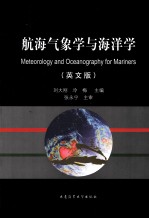图书介绍
航海气象学与海洋学 英文版PDF|Epub|txt|kindle电子书版本下载

- 刘大刚,冷梅主编;张永宁主审 著
- 出版社: 大连:大连海事大学出版社
- ISBN:9787563225477
- 出版时间:2011
- 标注页数:137页
- 文件大小:40MB
- 文件页数:145页
- 主题词:航海学:气象学;海洋学
PDF下载
下载说明
航海气象学与海洋学 英文版PDF格式电子书版下载
下载的文件为RAR压缩包。需要使用解压软件进行解压得到PDF格式图书。建议使用BT下载工具Free Download Manager进行下载,简称FDM(免费,没有广告,支持多平台)。本站资源全部打包为BT种子。所以需要使用专业的BT下载软件进行下载。如BitComet qBittorrent uTorrent等BT下载工具。迅雷目前由于本站不是热门资源。不推荐使用!后期资源热门了。安装了迅雷也可以迅雷进行下载!
(文件页数 要大于 标注页数,上中下等多册电子书除外)
注意:本站所有压缩包均有解压码: 点击下载压缩包解压工具
图书目录
CHAPTER 1 BASIC KNOWLEDGE OF THE ATMOSPHERE AND METEOROLOGI-CAL ELEMENTS1
1.1 The Atmosphere1
1.1.1 Introduction1
1.1.2 Vertical Structure of the Atmosphere1
1.1.3 Composition of the Atmosphere2
1.2 Solar Radiation and Air Temperature4
1.2.1 Solar Radiation4
1.2.2 Air Temperature and Temperature Scales5
1.2.3 Diurnal and Annual Variations of Air Temperature6
1.3 Atmospheric Pressure6
1.3.1 Air Pressure and Its Units6
1.3.2 Variation of Pressure with Height7
1.3.3 Diurnal and Annual Variations of Air Pressure8
1.3.4 Isobars8
1.3.5 Pressure Gradient8
1.3.6 Common Types of Pressure Fields9
1.4 Stability of the Atmosphere10
1.4.1 Concept of Stability10
1.4.2 Adiabatic Lapse Rate11
1.4.3 Equilibrium of Stability11
1.4.4 Stability and Weather12
1.5 Air Humidity13
1.5.1 Characteristics of Vapor in the Atmosphere13
1.5.2 Description of Air Humidity13
1.5.3 Variations of Absolute Humidity15
1.5.4 Variations of Relative Humidity15
1.6 Wind15
1.6.1 Defiinition and Description of Wind15
1.6.2 The Beaufort Scale of Wind Force16
1.6.3 Geostrophic Wind and Gradient Wind18
1.6.4 Buys Ballot’s Law20
1.6.5 The Effect of Friction20
1.7 Clouds and Precipitation21
1.7.1 The Formation of Clouds21
1.7.2 The International Classifiication of Clouds21
1.7.3 Cloud Cover24
1.7.4 Types of Precipitation24
1.7.5 Intensity of Precipitation25
1.8 Visibity and Fog26
1.8.1 Defiinition and Classifiication of Visibility26
1.8.2 Defiinition and Classification of Fog27
1.8.3 Main Types of Fog28
1.9 Shipborne Observation and Shipborne Meteorological Instruments29
1.9.1 Shipborne Observations29
1.9.2 Code Used for the Transmission of Ships Weather Messages29
1.9.3 Non-Routine Reports29
1.9.4 Visibility Measurement30
1.9.5 Wind Measurement31
1.9.6 Temperature Measurement31
1.9.7 Air Pressure Measurement32
1.9.8 Weather Phenomena33
1.9.9 Cloud Types and Amounts34
1.9.10 Observing Ocean Waves35
CHAPTER 2 WEATHER SYSTEMS36
2.1 Weather Charts36
2.1.1 Outline of Weather Charts36
2.1.2 Weather Chart Projections36
2.1.3 Surface Charts38
2.2 Air Masses and Fronts41
2.2.1 Air Mass41
2.2.2 Front Classification43
2.2.3 Frontal Elements44
2.2.4 Weather and Fronts45
2.3 Extra-tropical Anticyclone53
2.3.1 Outline of Anticyclone53
2.3.2 Siberian High54
2.3.3 Weather Associated with the Extra-tropical Anticyclone55
2.3.4 Movement of Extra-tropical Anticyclone55
2.3.5 Cold Air Grades56
2.4 Subtropical High56
2.4.1 Formation and Distribution56
2.4.2 Monitoring of the Northwest Pacifiic Subtropical High57
2.4.3 Migration of Subtropical High57
2.4.4 Subtropical High Weather58
2.5 Extratropical Cyclone59
2.5.1 Outline Extratropical Cyclone59
2.5.2 Cyclogenesis60
2.5.3 Weather Associated with Extratropical Cyclones61
2.5.4 Cyclone Tracking62
2.6 Tropical Cyclones62
2.6.1 Outline of Tropical Cyclone62
2.6.2 Locations and Seasons64
2.6.3 Classifiications, Terminology and Naming66
2.6.4 Chinese Warning System69
2.6.5 Conditions Necessary for the Formation of TCs70
2.6.6 Structure and Size70
2.6.7 Dissipation of Tropical Cyclones73
2.6.8 Movement and Track74
2.6.9 Observation and Forecasting76
2.6.10 Avoiding Tropical Cyclones78
CHAPTER 3 BASIC KNOWLEDGE OF CLIMATOLOGY84
3.1 Wind and Pressure Systems84
3.1.1 Three-cell Circulation Model84
3.1.2 Major Wind Patterns86
3.1.3 Observed Wind and Pressure Fields88
3.1.4 Monsoon89
3.1.5 Sea and Land Breezes94
3.2 Areas and Seasons of Strong Winds at Sea95
3.3 Distribution of Sea Fog96
3.3.1 General Distribution of Sea Fog96
3.3.2 Foggy Locations in the Ocean97
CHAPTER 4 BASIC KNOWLEDGE OF OCEANOGRAPHY99
4.1 Ocean Currents99
4.1.1 Outline of Ocean Currents99
4.1.2 The Formation of Currents100
4.1.3 Main Ocean Currents101
4.1.4 El Ni no-Southern Oscillation (ENSO)103
4.2 Sea Waves104
4.2.1 Description of Sea Waves104
4.2.2 Formation of Waves105
4.2.3 Types of Wind Waves105
4.2.4 Effects of Currents on Waves107
4.2.5 Effects of Ice on Waves107
4.2.6 Tsunamis107
4.2.7 Storm Tides109
4.3 Sea Ice109
4.3.1 Types of Sea Ice109
4.3.2 Iceberg Drift110
4.3.3 Extent of Ice in the Sea111
CHAPTER 5 WEATHER INFORMATION AND SERVICES113
5.1 Weather Information for Shipping113
5.1.1 Introduction of WMO113
5.1.2 Receiving Marine Weather Forecast Products Onboard114
5.1.3 Radiofax Weather Charts115
5.2 Interpretation and Application of Weather Charts116
5.2.1 Interpretation and Application of Surface Charts116
5.2.2 Interpretation and Application of Wave Charts121
5.2.3 TC Warning Reports and TC Forecast Charts124
5.2.4 Interpretation and Application of Satellite Imagery125
5.2.5 Interpretation and Application of Other Charts127
5.3 Introduction to Weather Routing130
5.3.1 Outline of Weather Routing130
5.3.2 Ship and Cargo Considerations131
5.3.3 Environmental Factors132
5.3.4 Synoptic Weather Considerations134
5.3.5 Types of Recommendations and Advisories135
5.3.6 Communications136
Bibliography137